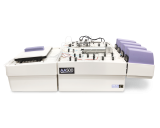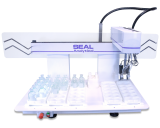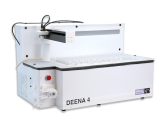Nitrite
As a critical component in the analysis of water quality and nutrient cycling, nitrite analysis provides valuable information to analysts and researchers in a wide range of fields. This test is easily automated on SEAL discrete analyzers and continuous flow analyzers alike - bringing incredible sample throughputs and the lowest detection limits to labs of all sizes.
Why is Nitrite Analysis Important?
Nitrite analysis plays a critical role across environmental, agricultural, and commercial sectors, serving as a key indicator of water quality, nutrient cycling, and process efficiency. As an intermediary in the nitrogen cycle, nitrite levels provide insight into the effectiveness of nitrification and denitrification processes in natural waters and wastewater systems. Elevated nitrite concentrations can signal pollution from agricultural runoff, industrial discharge, or treatment plant inefficiencies, making it an essential metric for safeguarding aquatic ecosystems and ensuring compliance with water quality regulations like those set by the EPA and ISO. By monitoring nitrite, scientists and regulators can protect aquatic life, maintain healthy water systems, and meet stringent safety standards.
In agriculture, nitrite testing provides vital data for soil and fertilizer management by tracking nitrogen transitions within the nitrogen cycle. This transitional form of nitrogen helps farmers and agronomists fine-tune fertilizer regimens to maximize crop yields while minimizing runoff and its associated environmental impacts. Additionally, analyzing nitrite in plant tissues reveals nutrient uptake efficiency, enabling precision agriculture practices that optimize productivity and support sustainable farming.
In commercial and industrial applications, nitrite serves as both a valuable process tool and a potential environmental concern. In the food and beverage industry, nitrite is widely used as a preservative in cured meats, where it prevents bacterial growth and ensures product safety and shelf life. Monitoring nitrite levels ensures compliance with food safety regulations and consistent product quality. In industrial effluents, nitrite monitoring is also critical in adhering to environmental discharge regulations and preventing downstream pollution. Whether ensuring product quality or safeguarding natural resources, nitrite analysis underpins a wide range of applications that benefit from accurate and reliable methods, making it an indispensable focus in laboratory testing and automation.
What's the Automation Advantage?
| 1. High Sensitivity and Low Detection Limits:Automated analyzers can deliver ultra-low detection limits for nitrite analysis, making them ideal for applications such as drinking water, seawater, and other sensitive matrices. Our AutoAnalyzer systems utilize advanced detection technologies to achieve extreme precision and reproducibility, ensuring regulatory compliance and reliable data in even the most challenging samples. | 2. Enhanced Efficiency Across Multiple Analytes: Automating nitrite analysis on a discrete analyzer orcontinuous flow analyzer not only streamlines the testing process for this specific analyte but also allows laboratories to efficiently analyze a variety of parameters, such as nitrate, ammonia, and phosphate, on the same run. This multipurpose capability reduces the need for multiple instruments, saving time and valuable bench space. | |
| 3. Consistent and Reliable Results: Automated systems ensure reproducible results by minimizing human error in sample handling and measurement. With precise calibration and consistent workflows, laboratories can meet regulatory standards with confidence, whether performing environmental water testing, soil nutrient analysis, or industrial effluent monitoring. | 4. Reduced Analyst Labor: Automation frees analysts from repetitive manual tasks like sample filtering or spec readings, allowing them to focus on more critical laboratory duties. This automated approach boosts overall productivity and improves operational efficiency in busy testing environments. |
SEAL's Expertise in Automated Nitrite Analysis
With over 60 years of experience in automating environmental analysis methods, SEAL Analytical has established itself as a global leader in nitrite testing and nutrient analysis. Our legacy goes back to the revolutionary AutoAnalyzer and AutoAnalyzer II— the original continuous flow analyzers developed by Technicon and later refined under SEAL Analytical. This groundbreaking technology served as the backbone for many EPA-approved methods and remains foundational in laboratories worldwide. SEAL Analytical has carried this legacy forward, enhancing the technology and developing modern automated solutions that meet the demands of today’s environmental, agricultural, and industrial testing laboratories.
SEAL Analytical’s leadership is built on a foundation of scientific expertise, with a team of chemists and leaders who bring firsthand laboratory and technical experience. We offer both discrete analyzers and continuous flow analyzers, enabling laboratories to choose the approach that best aligns with their unique testing needs, whether focused on nitrite or multiparameter nutrient analysis. This flexibility, combined with SEAL’s commitment to precision and reliability, ensures that our systems deliver low detection limits, excellent reproducibility, and unmatched performance for nitrite analysis. By blending decades of expertise with customer-focused innovation, SEAL Analytical continues to set the standard for automated nitrite testing solutions.
Key Nitrite Methods and Features
SEAL Analytical’s expertise in nitrite analysis covers a wide range of approved methods, providing unmatched support for environmental water testing, wastewater analysis, nutrient monitoring, and beyond. Our instrumentation automates methods according to 40 CFR 136, 40 CFR 141, and other regulatory guidelines. Common reference methods for SEAL's nitrite method library include
- EPA 353.2 (bypass cadmium reduction)
- Standard Methods 4500-NO3-F (bypass cadmium reduction)
- ISO 6777
- ISO 13395
- ISO 14673-2
- ISO 15923-1
Beyond nitrite detection, SEAL Analytical’s discrete analyzer and continuous flow analyzer product lines support an array of automated processes, including dilution, auto-calibration, automatic QC insertion, and the sequential or simultaneous analysis of multiple parameters. By combining these powerful features with regulatory-approved methods, SEAL Analytical ensures your lab’s nitrite analysis is not only compliant and efficient, but also capable of delivering consistent, precise, and high-quality results.
Compare our Analyzers
Explore the capabilities of each of our product lines below. Our analyzers and robotic systems are capable of analyzing a wide variety of analytes on a single platform. Select a product line to learn more about the capabilities of each system.
Ready to Optimize Your Nitrite Analysis?
Request Information
Fill out the form below to request information about our products and services.


.png?resolution=160x128&quality=95)

